Cuando hay santos nuevos los viejos no hacen milagros
2023
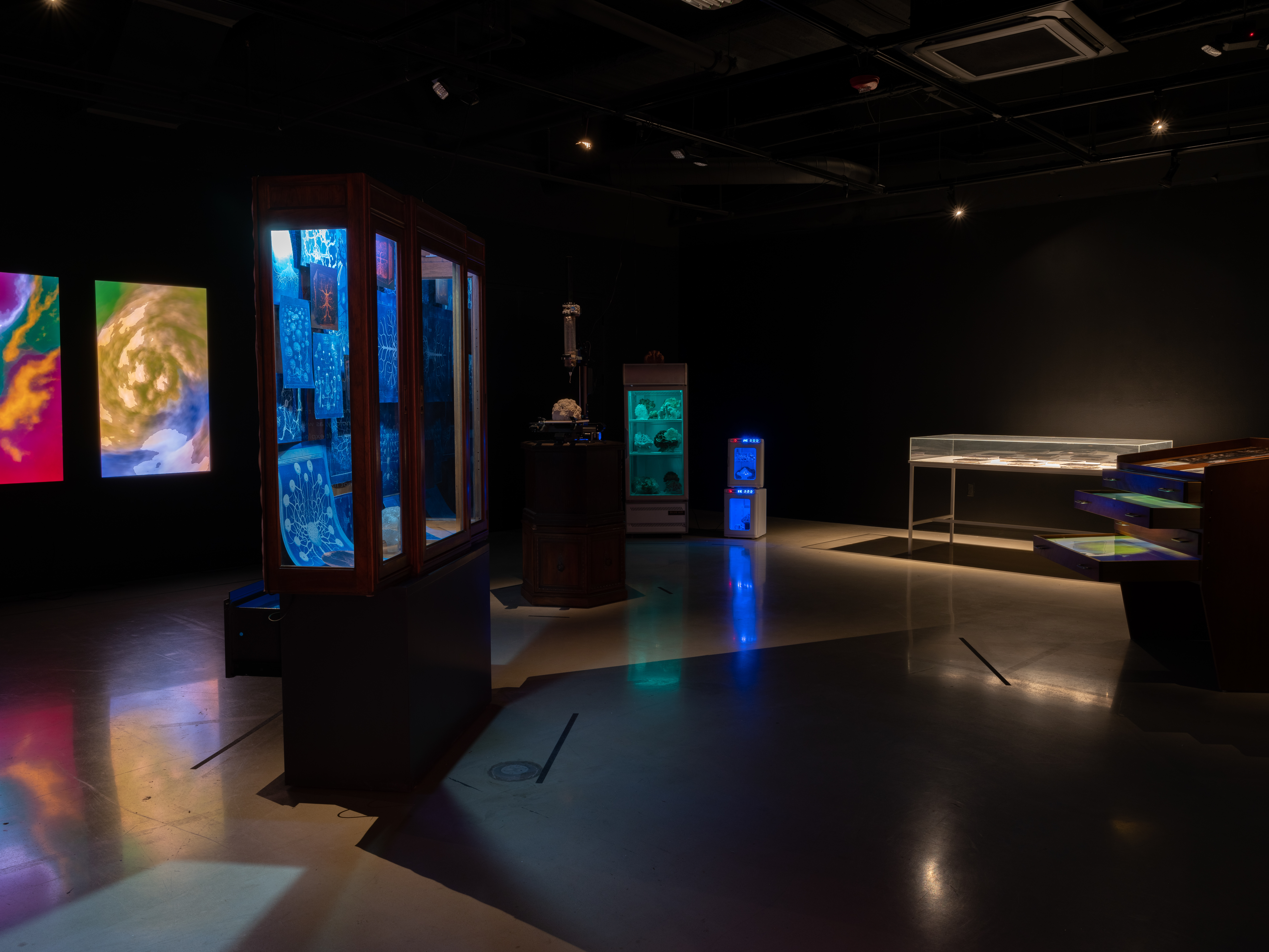
This work presents a series of archives, specimens, and objects that explore the complex relationship of nature and technology, as well as the way they have shaped knowledge production historically. It explores the speculative interactions between fungi, slime mold, and artificial intelligence processes, while addressing particular problems such as illegal mining activities in Venezuela. A space where nature and technology are not opposed but intertwined, where categories are not fixed but fluid.
The work is divided into several stations, each one commenting on a particular facet of these interactions
STATION 1: THE DIAGRAMMATICAL
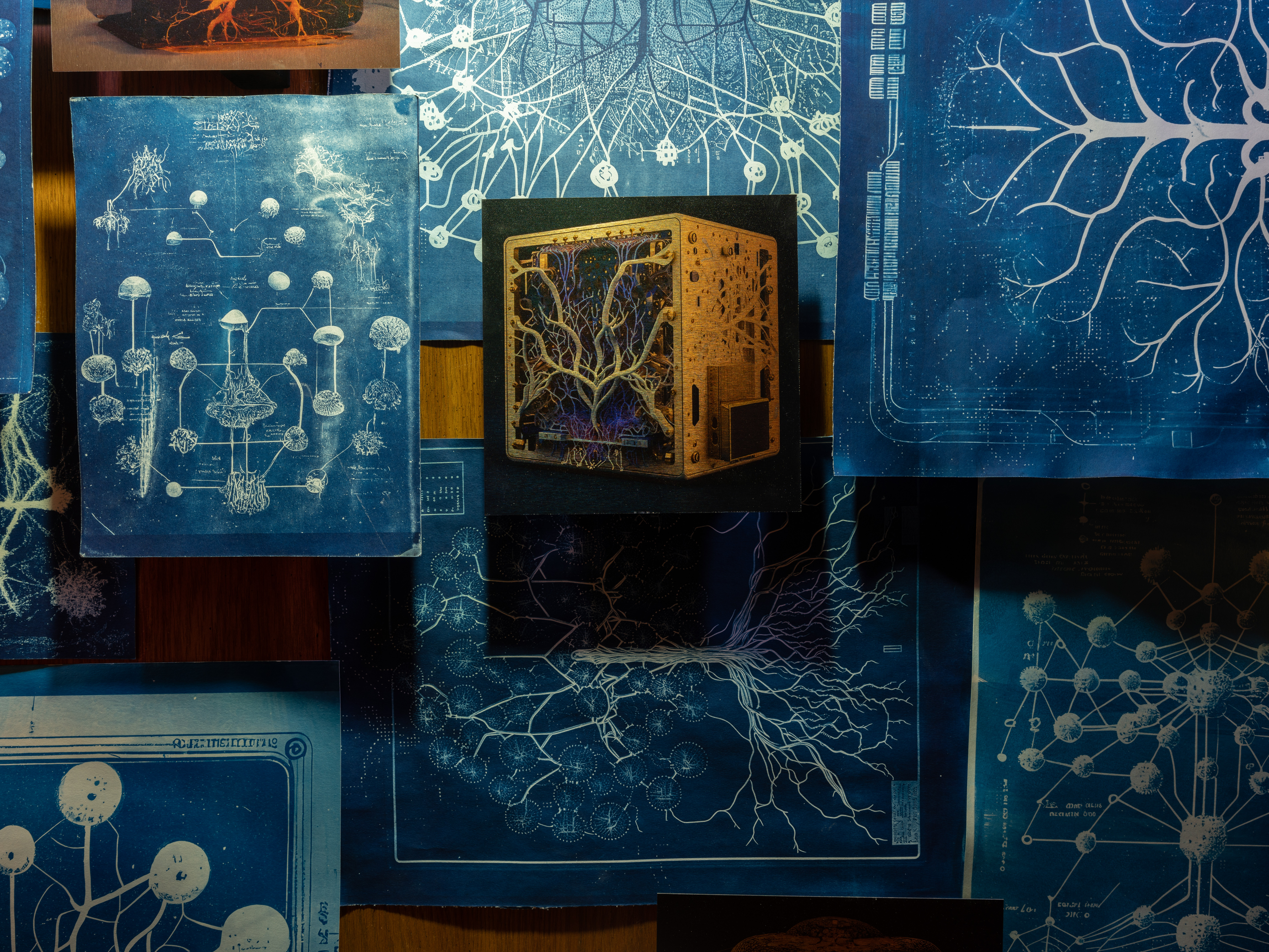
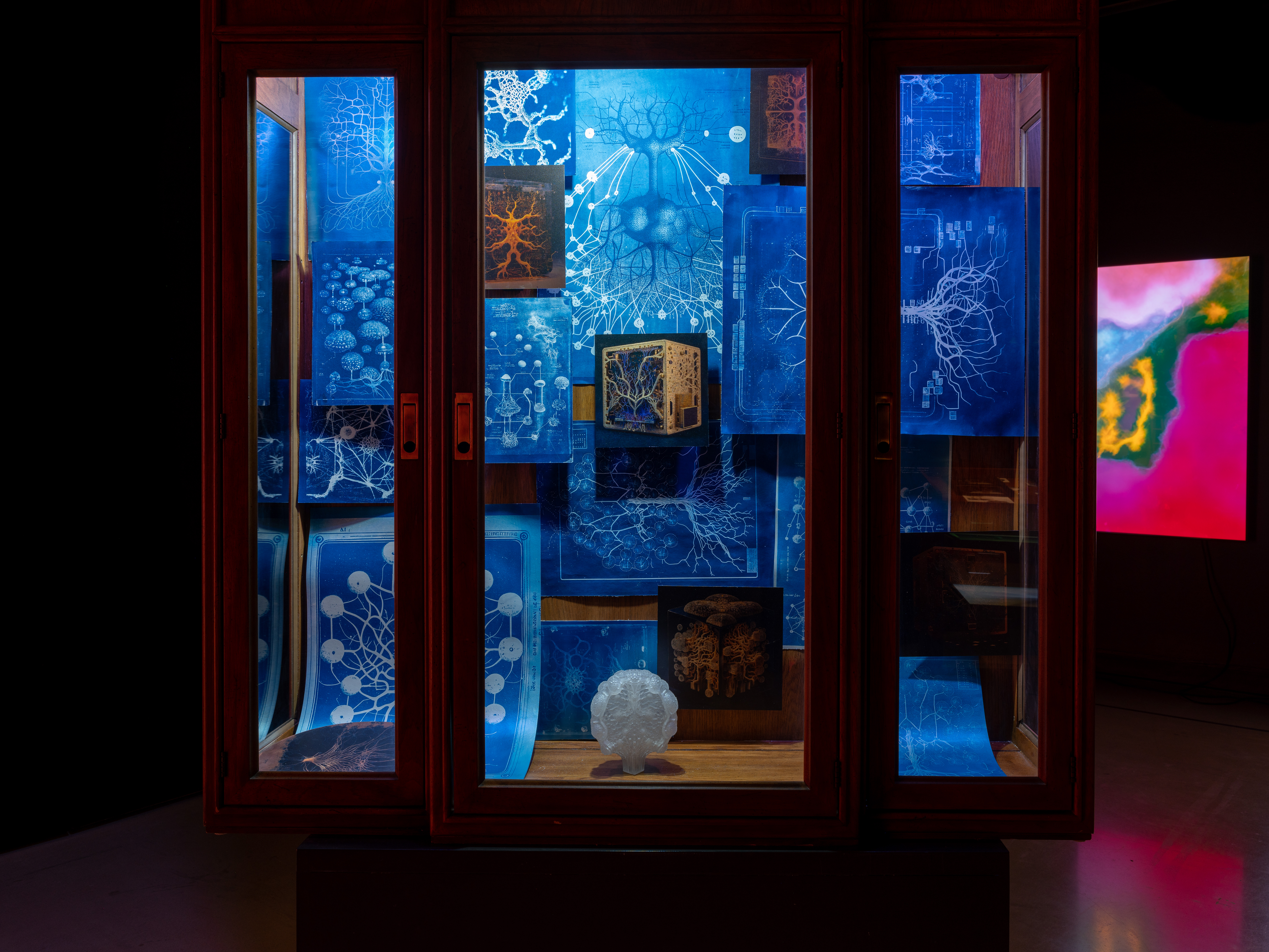
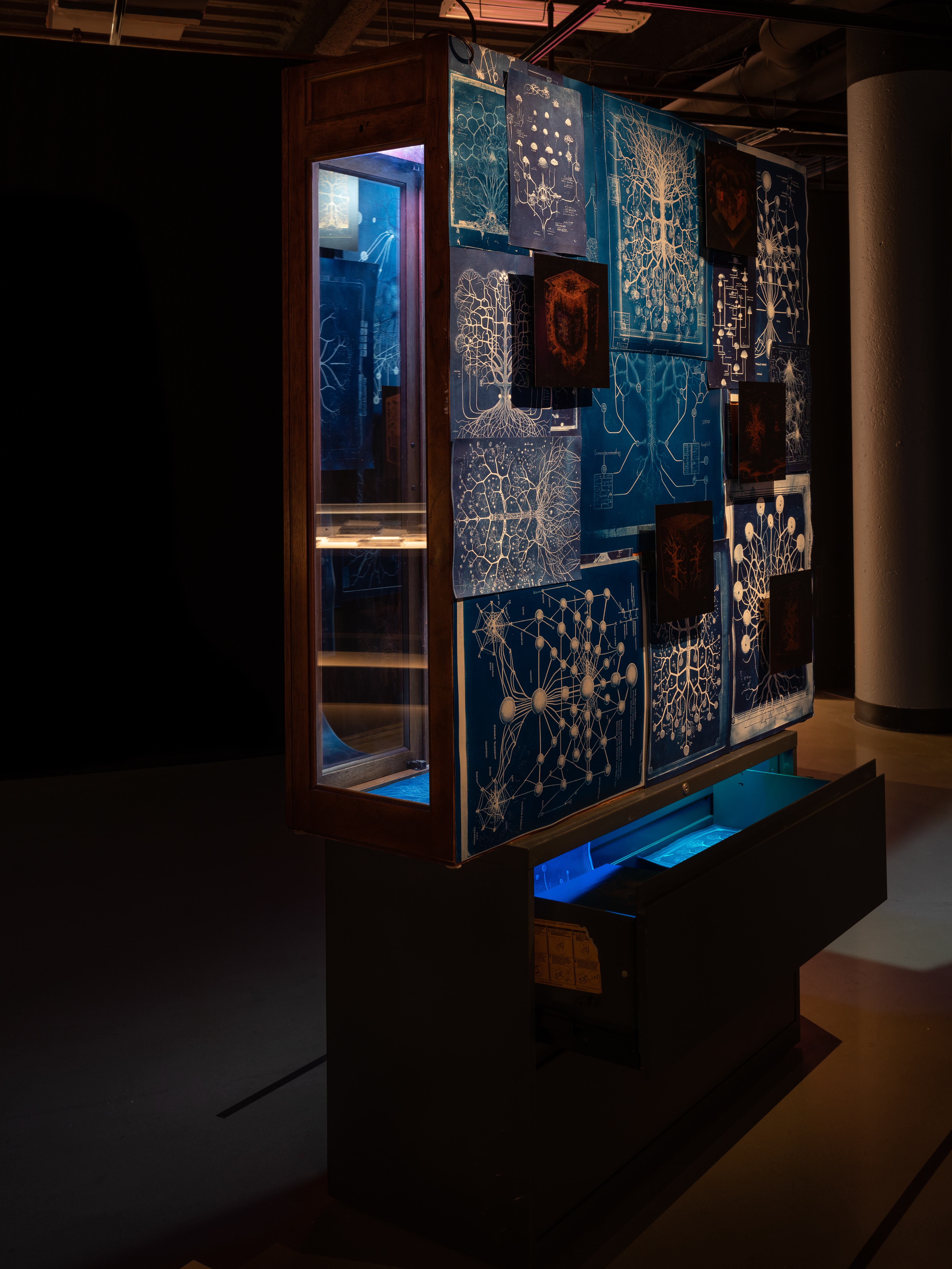



The work showcases a collection of cyanotypes and UV prints on copper-plated aluminum sheets, housed within a wooden vintage display cabinet and a metallic file cabinet. The blueprints are arranged haphazardly in the cabinets, making it difficult to distinguish them as individual pieces of information. They were created using machine learning processes, with prompts such as “a diagram of a mycelium network and an artificial neural network having a conversation” or “a diagram of a mycelium network and an artificial neural network hybrid.”
The intention behind this particular body of works is to explore the speculative interaction between contrasting systems by employing tools intrinsically linked to objects considered as traditional repositories of knowledge, such as blueprints and cabinets. By framing these fictional elements with aesthetic characteristics that could be interpreted as museological, I aim to propose alternative methods of understanding and engaging with technology and nature that challenge the prevailing dominant notions of material progress.
Simultaneously, the visual elements exhibit an inexplicable organic quality that entices viewers to question whether the display is real or imagined, and whether it can be rationally understood. Ultimately, the inherent nature of the elements used in this work resides in a realm of uncertainty. Consequently, even with an abundance of information about their nature, the possibility for complete understanding remains limited.
The intention behind this particular body of works is to explore the speculative interaction between contrasting systems by employing tools intrinsically linked to objects considered as traditional repositories of knowledge, such as blueprints and cabinets. By framing these fictional elements with aesthetic characteristics that could be interpreted as museological, I aim to propose alternative methods of understanding and engaging with technology and nature that challenge the prevailing dominant notions of material progress.
Simultaneously, the visual elements exhibit an inexplicable organic quality that entices viewers to question whether the display is real or imagined, and whether it can be rationally understood. Ultimately, the inherent nature of the elements used in this work resides in a realm of uncertainty. Consequently, even with an abundance of information about their nature, the possibility for complete understanding remains limited.
STATION 2: THE DIGITAL
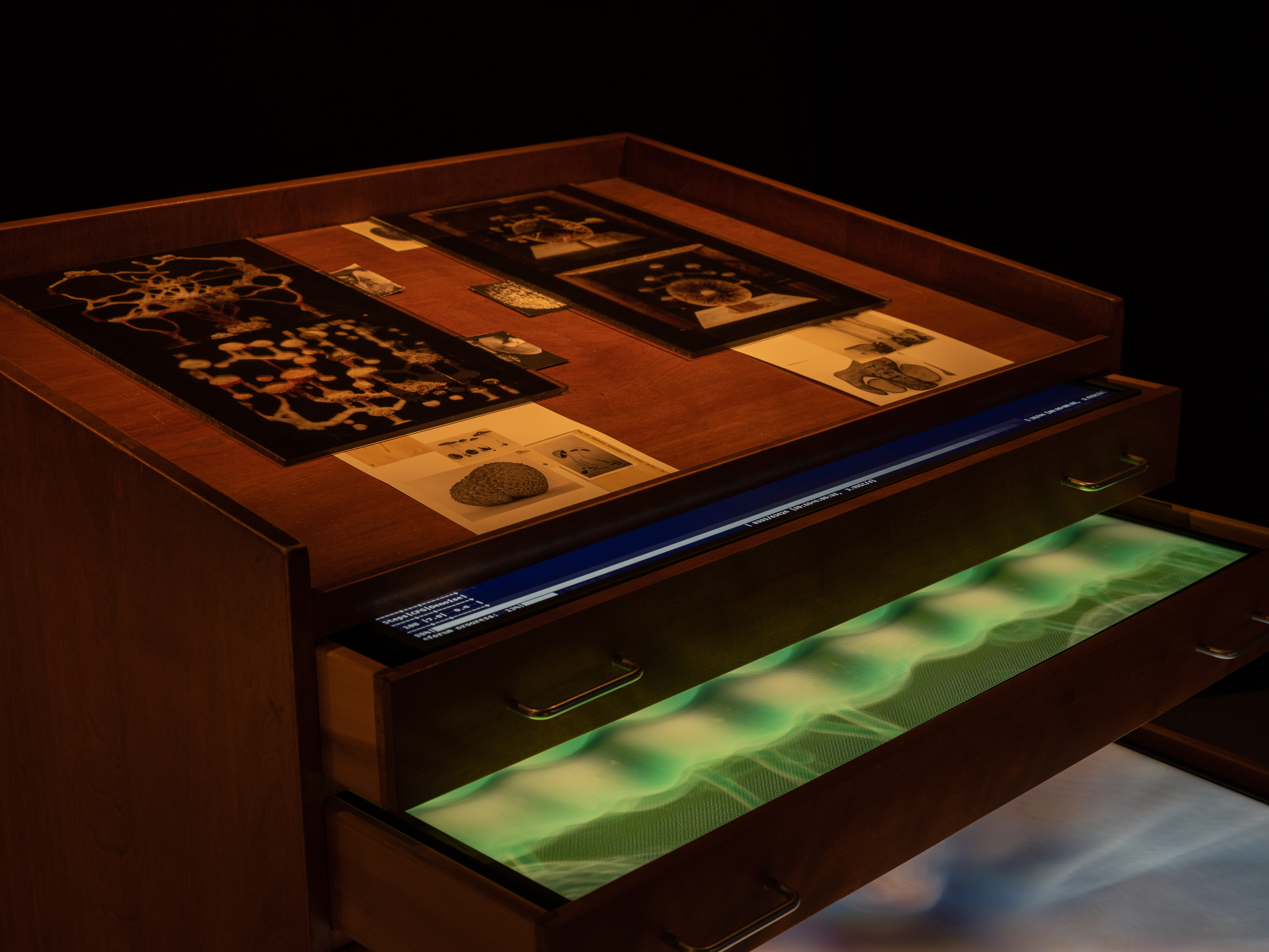
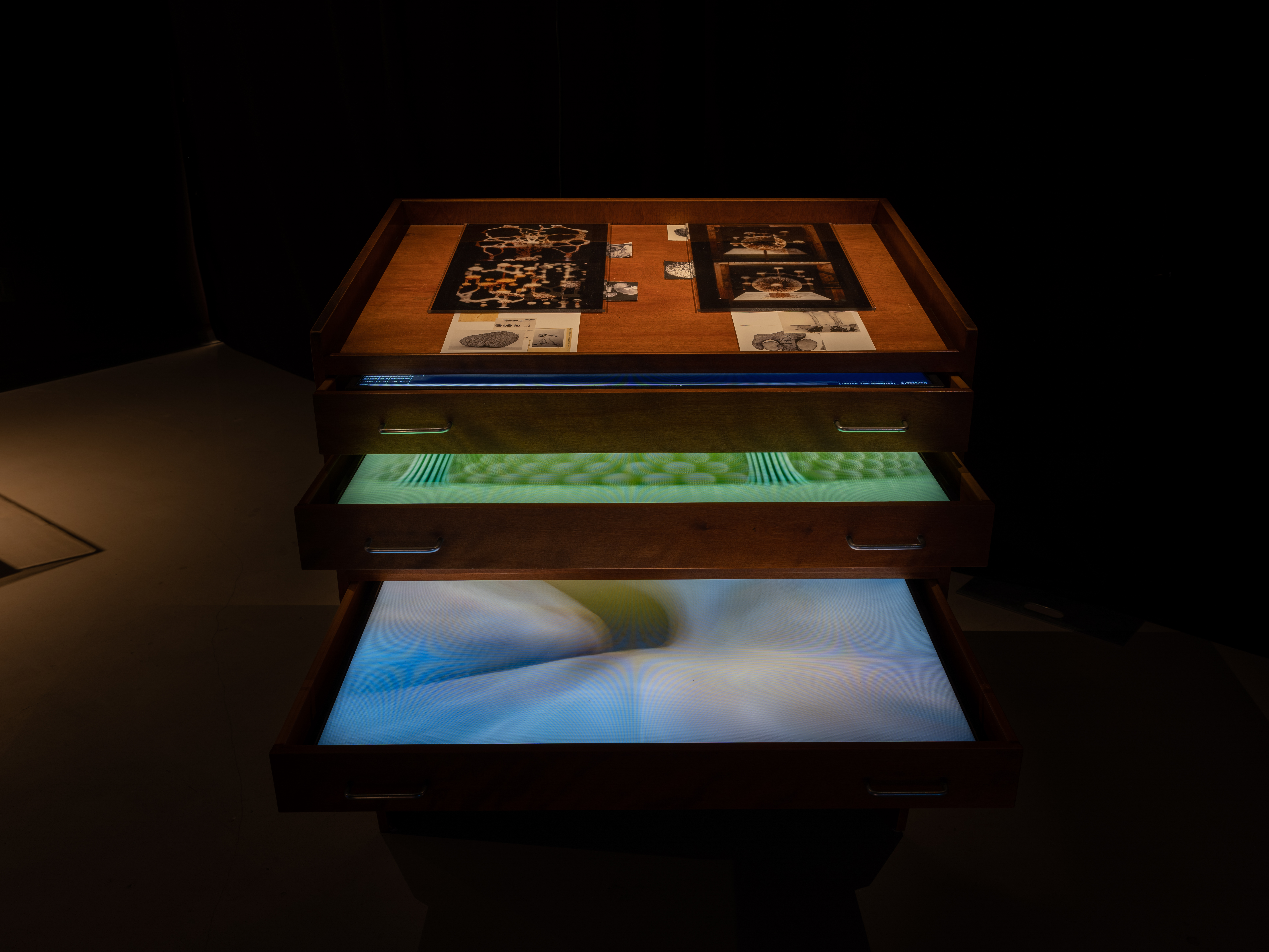

Three 40-inch TVs are seamlessly integrated into the drawers of a vintage wooden flat file. The TVs display videos created by machine learning algorithms, visualizing possible interactions between mycelium networks and artificial neural networks. Unlike the diagrammatic representations featured in the display cabinet, the outputs in this piece closely resemble a virtual 3D render, offering a moving portrayal of these complex systems interacting.
The flat file serves as a symbol of the convergence between the analog and digital worlds. The digital data presented on the screens replaces traditional analog forms of data transmission, such as documents, maps, and blueprints. The drawers are purposefully arranged to reveal only certain sections of the video content, alluding to the intricate nature of the systems depicted.
One of the videos displays a command window that tracks the progress of the machine learning model as it is trained. This creates the illusion that the other videos within the installation are being generated live, adding an element of intrigue. However, in reality, they are pre-recorded. By incorporating this element, an additional layer of fiction within the piece is introduced, blurring the lines between fact and fabrication.
STATION 3.1: THE PHYSICAL
![]()
![]()
A clay 3d printer is placed in vintage wooden furniture, given the novelty of the technology used in combination with an object from a past period of time there is sentiment of rarity that makes harder to the viewer to identify itself within an specific time period, such condition repeats in several of the other pieces as well.
The printer is activated during specific times of the installation, so viewers can have the opportunity to watch the printer creating these mycelium-ai hybrids. This introduces a time element into the reading of the work where questions of whether the pieces are new or old as well as about the nature of their materiality, as clay 3d printers are objects still too novel for people to easily recognize them. The presence of the clay 3d printer challenges viewers to question the reality of the rest of the elements presented in the space as there are similar pieces located within other stations.
STATION 3.2: THE PHYSICAL
![]()
![]()
![]()
![]()
![]()
The other display consists of one refrigerator and two laboratory incubator, instruments used in scientific research facilities in order to let organisms grow and to preserve their life cycles. In these containers, only objects useless for scientific purposes are presented. This section contains all the hybrid specimens that I created with 3d printing in combination with real fungi and other molds growing on top of the clay pieces. Such “specimens” acquire different connotations depending on the container they are placed in: in the incubators there is an allusion of something that is being created or grown the temperature of such equipment is set to 29 degrees celsius which are ideal conditions for many fungi species to grow, and they allude to the present and the future. On the other hand, the “specimens” in the fridge refer to something that is being preserved or stopped in a determined state; they allude to the past but a past that is unknown.
STATION 4: SPECULATING THE PARTICULAR
![]()
![]()
![]()
![]()
I trained machine learning models from the satellite images of the mining activities and combined those with prompts like “a neural network and slime mold network intervening in illegal mining activities in Venezuela”. The final result are video animations placed in two 65” Tv’s positioned vertically in the walls of the space.
Both actions present a data visualization that doesn’t lead to any functional knowledge, but it proposes at least two main different speculative readings of a particular situation: the first one would be to think about the slime mold / AI as a sort of regenerative agent that by feeding from the contaminants generated by such activities ends un covering and recovering the soil in order to allow new biological life to occur. The second one would be to use the slime mold / AI growth as a tool for visualization of the consequences of illegal mining activities in the future, where the contamination extends all over the territory. This multidirectional reading of the slime mold’s growth and decay refers to the incapacity to attain empirical knowledge about these two complex systems and their metaphorical interactions; this is not an attempt to make a statement but to raise questions and concerns regarding the intricacy of the matter with the use of an organism fitted with an intelligence different from human and a technology created by humans but whose properties and potentialities are yet to be discovered.
The flat file serves as a symbol of the convergence between the analog and digital worlds. The digital data presented on the screens replaces traditional analog forms of data transmission, such as documents, maps, and blueprints. The drawers are purposefully arranged to reveal only certain sections of the video content, alluding to the intricate nature of the systems depicted.
One of the videos displays a command window that tracks the progress of the machine learning model as it is trained. This creates the illusion that the other videos within the installation are being generated live, adding an element of intrigue. However, in reality, they are pre-recorded. By incorporating this element, an additional layer of fiction within the piece is introduced, blurring the lines between fact and fabrication.
STATION 3.1: THE PHYSICAL
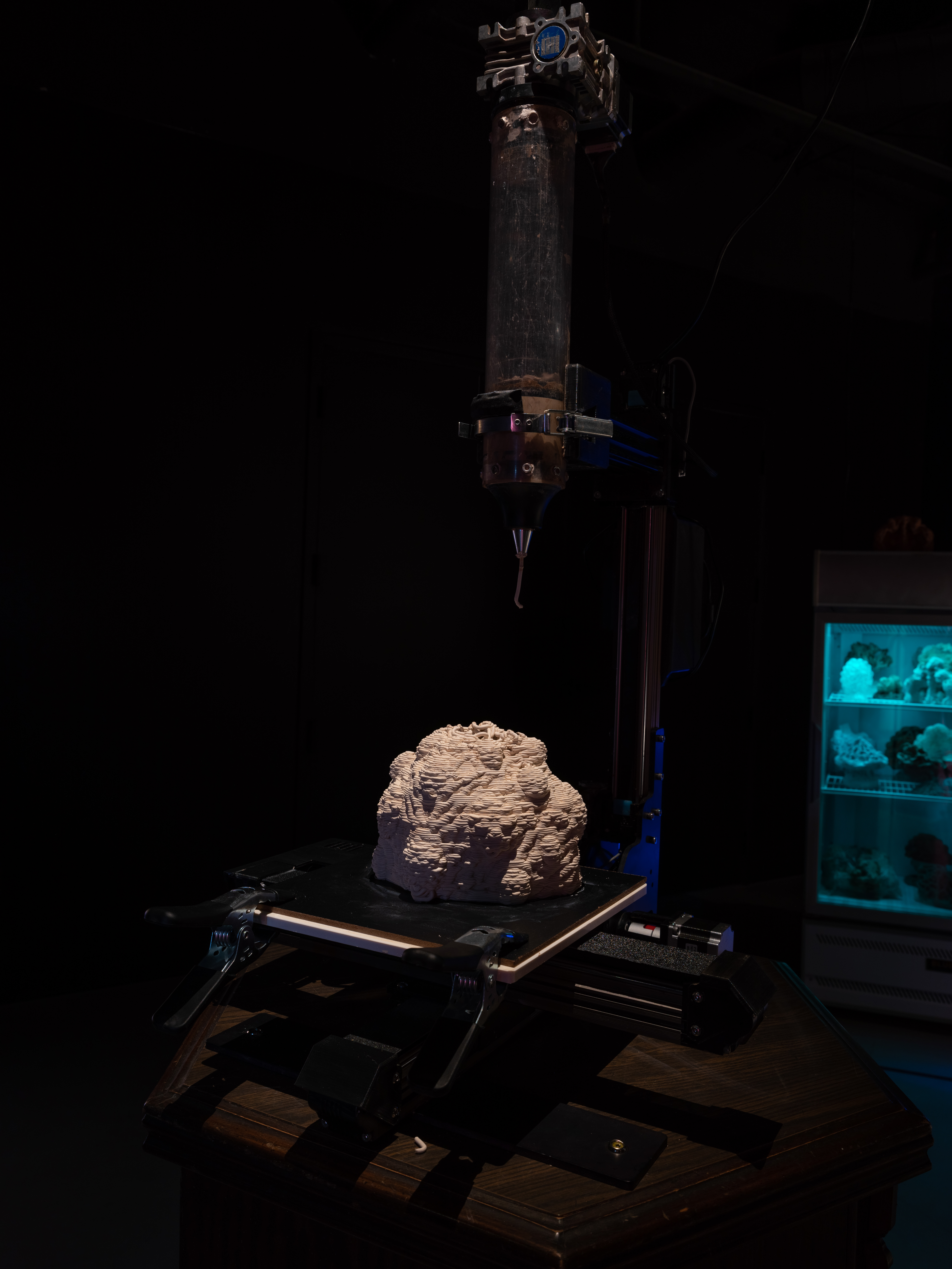

A clay 3d printer is placed in vintage wooden furniture, given the novelty of the technology used in combination with an object from a past period of time there is sentiment of rarity that makes harder to the viewer to identify itself within an specific time period, such condition repeats in several of the other pieces as well.
The printer is activated during specific times of the installation, so viewers can have the opportunity to watch the printer creating these mycelium-ai hybrids. This introduces a time element into the reading of the work where questions of whether the pieces are new or old as well as about the nature of their materiality, as clay 3d printers are objects still too novel for people to easily recognize them. The presence of the clay 3d printer challenges viewers to question the reality of the rest of the elements presented in the space as there are similar pieces located within other stations.
STATION 3.2: THE PHYSICAL



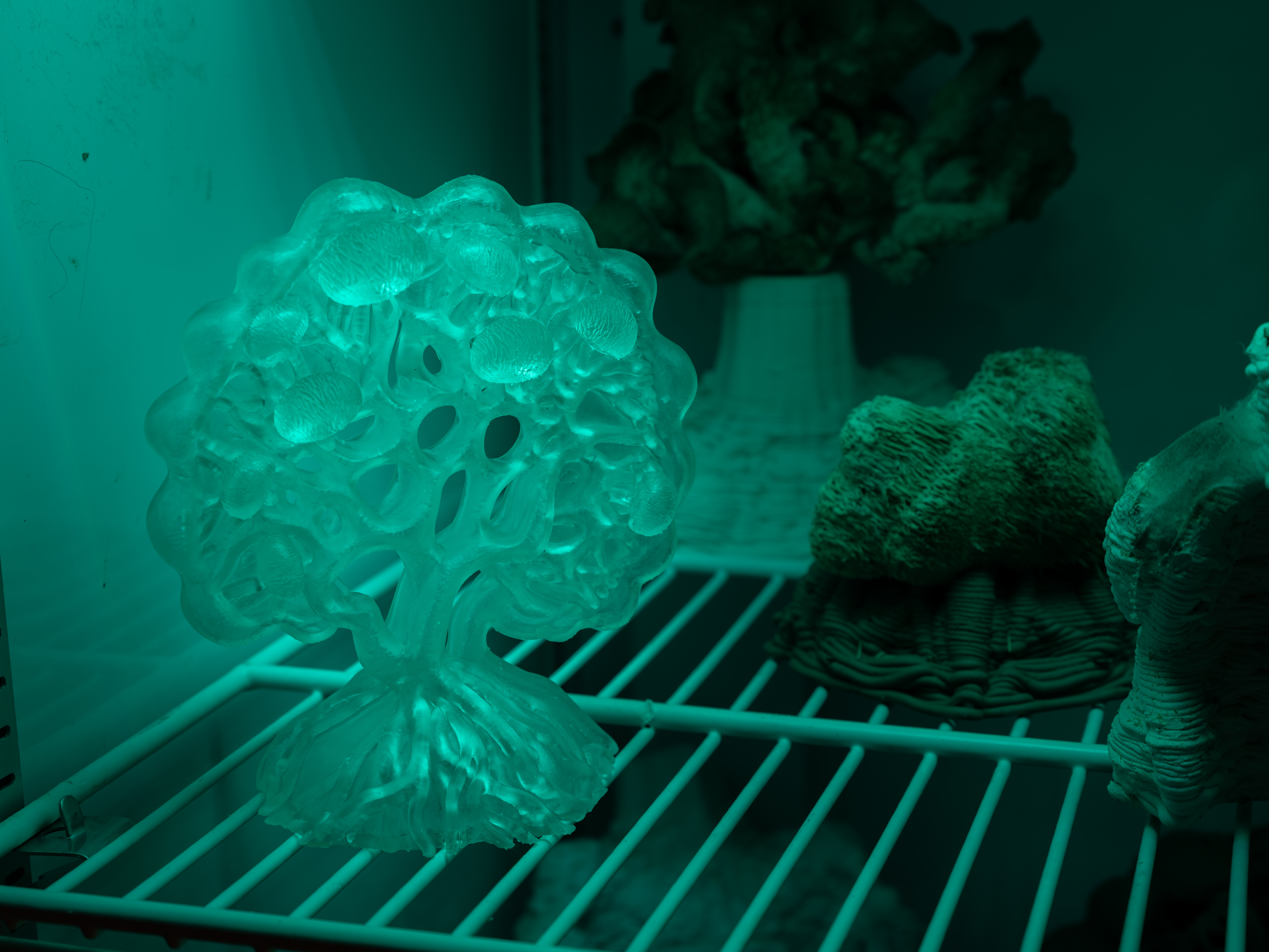

The other display consists of one refrigerator and two laboratory incubator, instruments used in scientific research facilities in order to let organisms grow and to preserve their life cycles. In these containers, only objects useless for scientific purposes are presented. This section contains all the hybrid specimens that I created with 3d printing in combination with real fungi and other molds growing on top of the clay pieces. Such “specimens” acquire different connotations depending on the container they are placed in: in the incubators there is an allusion of something that is being created or grown the temperature of such equipment is set to 29 degrees celsius which are ideal conditions for many fungi species to grow, and they allude to the present and the future. On the other hand, the “specimens” in the fridge refer to something that is being preserved or stopped in a determined state; they allude to the past but a past that is unknown.
STATION 4: SPECULATING THE PARTICULAR
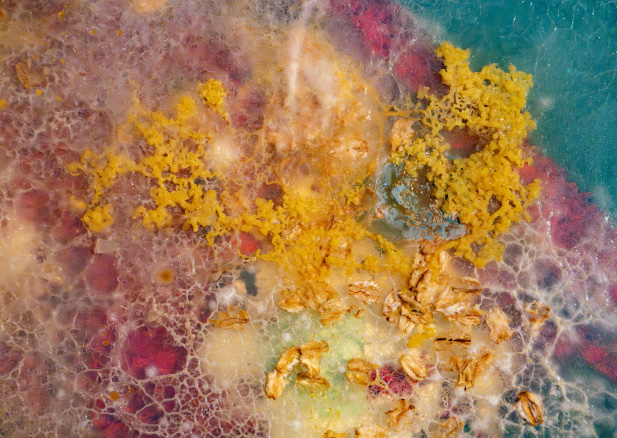
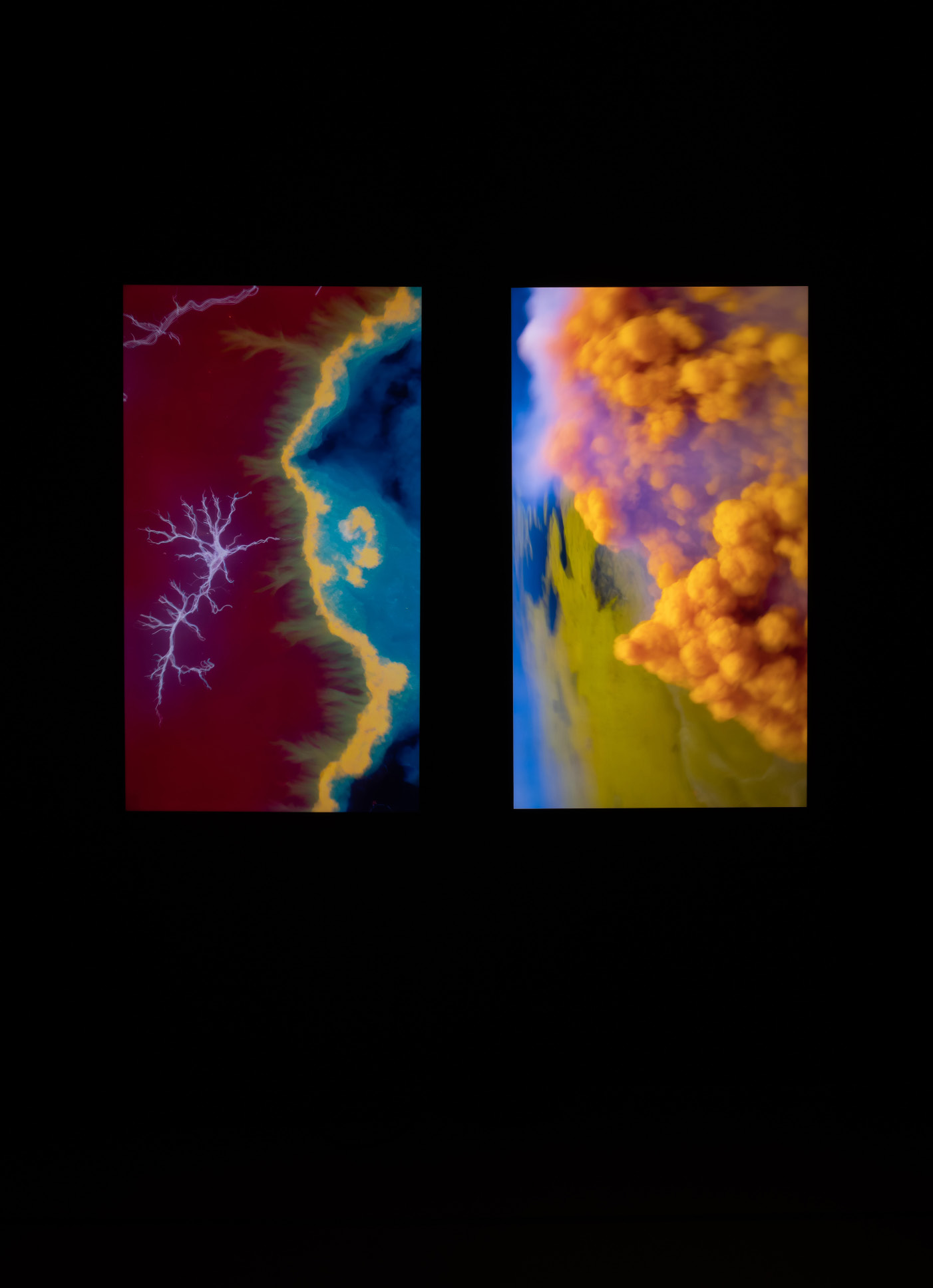


I trained machine learning models from the satellite images of the mining activities and combined those with prompts like “a neural network and slime mold network intervening in illegal mining activities in Venezuela”. The final result are video animations placed in two 65” Tv’s positioned vertically in the walls of the space.
Both actions present a data visualization that doesn’t lead to any functional knowledge, but it proposes at least two main different speculative readings of a particular situation: the first one would be to think about the slime mold / AI as a sort of regenerative agent that by feeding from the contaminants generated by such activities ends un covering and recovering the soil in order to allow new biological life to occur. The second one would be to use the slime mold / AI growth as a tool for visualization of the consequences of illegal mining activities in the future, where the contamination extends all over the territory. This multidirectional reading of the slime mold’s growth and decay refers to the incapacity to attain empirical knowledge about these two complex systems and their metaphorical interactions; this is not an attempt to make a statement but to raise questions and concerns regarding the intricacy of the matter with the use of an organism fitted with an intelligence different from human and a technology created by humans but whose properties and potentialities are yet to be discovered.